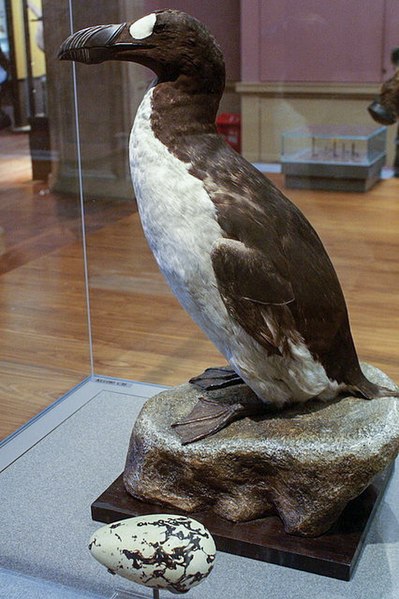Attēls:Great Auk (Pinguinis impennis) specimen, Kelvingrove, Glasgow - geograph.org.uk - 1108249.jpg

Šī priekšskata izmērs: 399 × 599 pikseļi. Citi izmēri: 160 × 240 pikseļi | 426 × 640 pikseļi.
Sākotnējais fails (426 × 640 pikseļi, faila izmērs: 271 KB, MIME tips: image/jpeg)
Faila hronoloģija
Uzklikšķini uz datums/laiks kolonnā esošās saites, lai apskatītos, kā šis fails izskatījās tad.
| Datums/Laiks | Attēls | Izmēri | Dalībnieks | Komentārs | |
|---|---|---|---|---|---|
| tagadējais | 2017. gada 11. augusts, plkst. 12.26 |  | 426 × 640 (271 KB) | Archaeodontosaurus | Corrections |
| 2011. gada 24. februāris, plkst. 20.46 |  | 426 × 640 (78 KB) | GeographBot | == {{int:filedesc}} == {{Information |description={{en|1=Great Auk (Pinguinis impennis) specimen, Kelvingrove, Glasgow A lost part of the biogeography of Britain, and the only flightless bird that has bred in Europe in historical times. The last Great Auk |
Faila lietojums
Šo failu izmanto šajās 2 lapās:
Globālais faila lietojums
Šīs Vikipēdijas izmanto šo failu:
- Izmantojums ar.wikipedia.org
- Izmantojums arz.wikipedia.org
- Izmantojums ast.wikipedia.org
- Izmantojums as.wikipedia.org
- Izmantojums az.wikipedia.org
- Izmantojums bg.wikipedia.org
- Izmantojums bn.wikibooks.org
- Izmantojums ca.wikipedia.org
- Izmantojums da.wikipedia.org
- Izmantojums de.wikipedia.org
- Izmantojums en.wikipedia.org
- Izmantojums en.wikibooks.org
- Izmantojums en.wiktionary.org
- Izmantojums es.wikipedia.org
- Izmantojums et.wikipedia.org
- Izmantojums eu.wikipedia.org
- Izmantojums fa.wikipedia.org
- Izmantojums fi.wiktionary.org
- Izmantojums fo.wikipedia.org
- Izmantojums fr.wikipedia.org
- Izmantojums fy.wikipedia.org
- Izmantojums ga.wikipedia.org
- Izmantojums gd.wikipedia.org
- Izmantojums gl.wikipedia.org
- Izmantojums he.wikipedia.org
- Izmantojums ia.wikipedia.org
- Izmantojums it.wikipedia.org
- Izmantojums ja.wiktionary.org
- Izmantojums jv.wikipedia.org
- Izmantojums la.wikipedia.org
- Izmantojums ml.wikipedia.org
- Izmantojums mrj.wikipedia.org
- Izmantojums no.wikipedia.org
Skatīt šī faila pilno globālo izmantojumu.
